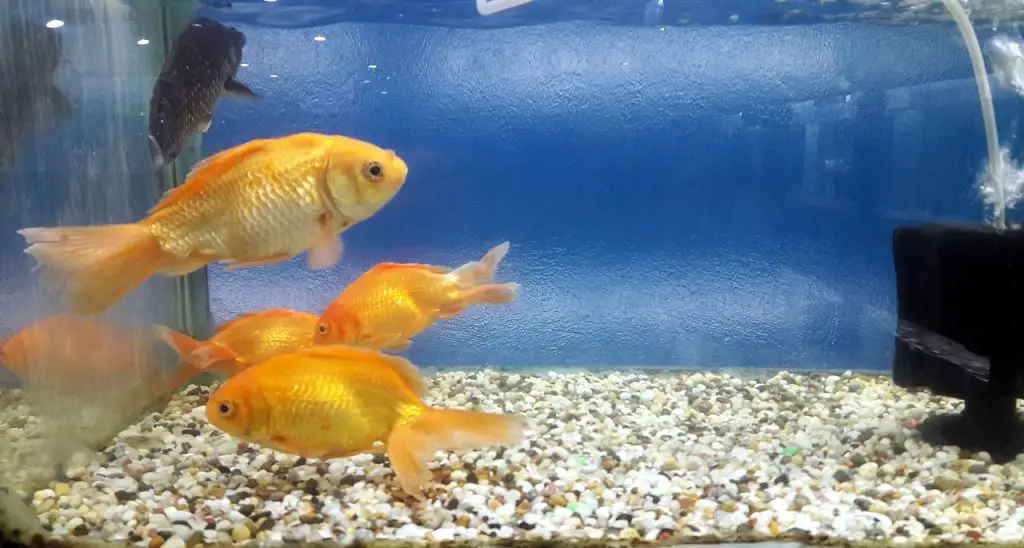Have you ever wondered what fish see when they’re swimming inside their aquarium?
As observers, we enjoy watching the array of colors and movements of our aquatic pets, but understanding their perspective can offer a different view of their world.
Fish possess unique visual capabilities that allow them to perceive their environment in ways that are different from ours.
When fish look out through the aquarium glass, they can see the room around them, although their view may be slightly distorted due to the refraction caused by the water and glass interface.
Fish can see straight into the room, but the reflections of the tank’s interior dominate their sight when viewing adjacent sides. Their view of the outside world is also affected by lighting conditions.
The presence of artificial and natural light from different angles can influence what they detect beyond the glass.
Vision in Aquatic Environments
Light Absorption
In the underwater environment, light absorption plays a significant role in influencing how fish perceive their surroundings.
As light travels through water, various wavelengths are absorbed at different rates, altering the colors and visibility of fish.
In general, red and orange wavelengths are absorbed more quickly, followed by yellow and green, while blue and violet wavelengths penetrate deeper into the water.
This selective light absorption results in a loss of color the deeper a fish is in the water column. Fish living in shallow, clear waters experience a wider range of colors and visibility than those in deeper or murkier waters, where light availability is limited.
Color Perception
The ability of fish to perceive colors underwater depends on their species-specific adaptations and the light conditions in their environment.
Some resident fish species are adapted to see ultraviolet light and are sensitive to polarized light. This adaptation can help them with tasks such as spotting prey or identifying potential mates.
Regarding the perception of color in their tank environment, fish may experience different color spectra compared to their natural habitats, depending on the water clarity and the type of artificial lighting used in the aquarium.
Therefore, to mimic the natural color spectrum for fish, appropriate lighting must cater to their specific visual needs.
In conclusion, fish can discern their surroundings from inside the tank, with their vision influenced by light absorption and color perception.
Therefore, to create an optimal environment for these aquatic creatures, they must account for their visual requirements to ensure a comfortable and healthy tank environment.
Fish Perspective from Inside the Tank
Acrylic or Glass Tank Distortion
Fish can indeed see outside of their aquarium, whether it’s made of acrylic or glass. However, the clarity and distortion might vary depending on the material used for the tank.
For example, with a glass aquarium, visibility might be slightly better when looking straight through the glass, whereas there could be some distortion when looking through the adjacent sides.
Acrylic tanks offer better clarity and less distortion overall, allowing fish a clearer view of their surroundings even when looking through angled panels.
Aquarium Size and Shape
The size and shape of the aquarium also play a role in what fish can see from inside their tank.
In smaller tanks, the fish may have a more limited view of the outside world due to the confinement of the space.
The fish have a broader perspective in larger tanks, and the view’s details become more prominent. Therefore, it’s essential to consider the size of your fish species when selecting an appropriate tank size for them.
Do fish see their reflection in the glass?
Fish can see their reflection in the glass of an aquarium under certain circumstances. This usually occurs when the light inside the tank is brighter than outside.
The glass acts as a mirror, reflecting the fish’s image at them. Fish may react differently to seeing their reflection; some might ignore it, while others may become aggressive or stressed.
To minimize potential reflection issues, you can adjust the tank’s lighting or add decorations as visual barriers inside the aquarium.
How Aquarium Decorations Affect Fish Vision
Plants and Hiding Spots
Plants and hiding spots in an aquarium serve different purposes for fish, such as providing shelter and creating a more natural environment.
Fish can see objects placed outside their tank, so adding plants and decorations helps them feel more secure and reduces stress.
When positioning plants and hiding spots, consider the natural habitats of your fish species. Clustering plants in some areas while leaving open spaces in others mimics their natural surroundings.
Reflections and Lighting
Lighting plays an essential role in how fish perceive their environment. However, reflections caused by the aquarium glass and water surface can impact their vision, making it difficult for them to see particular objects or recognize their human caretakers.
LED lights are preferred for aquariums, as they do not harm or hurt fish eyes and help maintain a healthy environment. However, be mindful of how different lighting levels affect your aquatic pets and adjust accordingly.
For example, keeping the tank area well-lit and avoiding sudden changes in external light can reduce reflections and make it easier for fish to see their surroundings.
Fish Interactions and Behavior
Territoriality and Tank Mates
Fish behavior can be influenced by the environment, especially regarding territoriality. Certain fish species are known to be territorial, defending their space from intruders.
Ensuring compatible tank mates can help prevent aggressive behavior and create a harmonious living environment for the fish.
Foraging and Feeding
Foraging and feeding habits vary among fish species. Some fish are active hunters, while others scavenge leftover food from their tank mates.
A varied diet of live or frozen foods, pellets, and flakes can encourage natural feeding behaviors.
Do Fish Watch You?
Evidence suggests that fish can recognize their owners and become accustomed to their presence.
Research on this topic shows that pet fish can detect movement outside their tank, often reacting to people they recognize.
For example, fish may associate their owner with feeding time and show excitement when their owner approaches the tank.
According to PetMD, experimental lab studies have provided insights into fish’s ability to detect their surroundings and human interactions.
Section 6: Improving Your Fish’s Visual Experience
Optimal Lighting
Fish are highly sensitive to their environment, and proper lighting is essential for their well-being.
Ensuring that the aquarium has a balance of natural and artificial light allows fish to perceive their surroundings accurately and maintain their natural behaviors.
Additionally, fish see a wider array of colors, including ultraviolet light, so providing a light spectrum that caters to their vision is essential for their visual experience (For Fish Lovers).
Consider adding LED lights or full-spectrum fluorescent bulbs that closely mimic natural sunlight. Maintain a consistent day/night cycle.
If your aquarium is in a low-light area, consider using a timer to regulate the lighting for your fish.
Enhancing the Habitat
Decorations and hiding spots within the aquarium make it appealing and increase the fish’s visual stimuli.
Fish enjoy exploring their environment, and adding plants, rocks, and other decors can help enhance their visual experience (Fish Tank Savvy).
Consider adding the following to your aquarium:
- Live or artificial plants: These provide shelter and a sense of security for your fish and improve their visual environment.
- Rocks and cave-like structures add dimension and provide hiding spots for your fish. Natural materials are more visually appealing for the fish and the aquarium’s overall aesthetic.
- Backgrounds: Adding a visually appealing background to the outside of the tank can help create a more stimulating environment for your fish, as they can see objects placed outside their tank (BeChewy).
Tailoring the aquarium environment to your fish’s natural habitat and providing optimal lighting will improve their visual experience and support their overall health and well-being.


